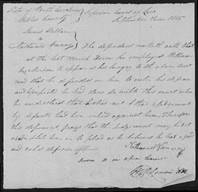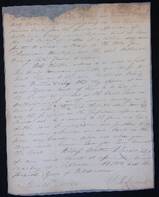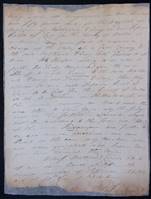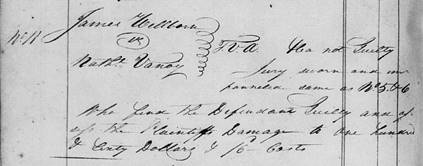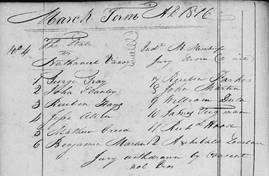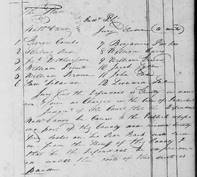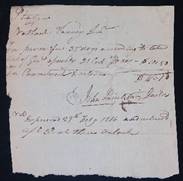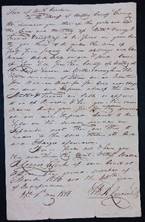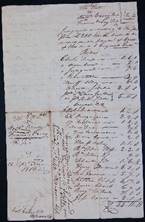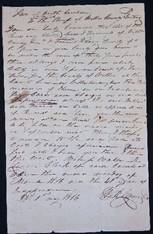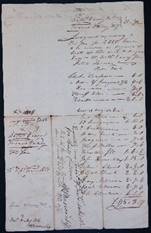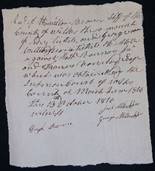Blog
Article List Home My Research Services Contact Me
|
Wilkes September 21, 2025 Nathaniel Vannoy: Not Saved by the Bell Many of the stories that I decide to
write about seem simple and straightforward when I begin, but they quickly
turn into something more complicated.
That’s what happened this time.
With each document that I found, there was another twist in the story
that wasn’t always explained in the documents that I’ve found. It’s like reading a mystery novel with
missing chapters: you know who the
characters are, but it’s hard to form a complete narrative about what they’re
up to. This became an interesting
story with several wellknown Wilkes County individuals, and I’m presenting the
documents that I’ve found in chronological order. Perhaps other researchers can add details
that tell an even more complete story about the legal problems faced by
Nathaniel Vannoy. Our story begins in October 1813 near
what is now called Rendezvous Mountain, either on the waters of the North
Fork of Lewis Fork or the South Fork of Reddies River. They were about twelve miles northwest of
the town of Wilkesboro. Nathaniel
Vannoy Jr. filed a complaint with a local justice of the peace, and a
transcription of his statement reads as follows: This day came Nathaniel
Vannoy Jnr before me and made oath that some time about the first of last
August last, he saw Samuel Wilcockson Jnr take a bel of or [i.e. take a bell
off of] a sorrel beast in Wilkes County.
Said Wilcockson told him he kild a good mare for Robt. Cleaveland and
shot another in the head that got well; and also said he kild another mare
for Stokes; and cut of the years [ears] of another. Said Wilcockson showed him
three bels hid under a logue [log] and said Squire Wilcockson had agreed with
him to give him 25 cents apiece for them, and saw him send them to said
Squire Wilcockson by George Wilcockson which is contrary to the law and dignity
of the state. Therefore, this is to
command you to take the body of said Wilcockson and him safely keep so that
he may be dealt with as the law directs, given under my hand and seal this 28
day of October, 1813. Summons in
behalf of the state Nathaniel Vannoy Jnr. The back of the page is dated November
27, 1813, with the names of those who are bound by the court as documented by
Jesse Robinett, justice of the peace, in the case of “The State against
Wilcockson Samuel”. I find cause sufficient to
bind the deft. to our next Superior Court to be held for this county of
Wilkes in two securities, each one hundred pounds and himself in the sum of
two hundred pounds. Samuel Wilcoxson Sam Wilcoxson Frs. Barnard The prosecutor bound in the
sum of one hundred pounds. Solomon Doss Nathaniel Vannoy Jnr Witnesses bound in the sum
of fifty pounds each. Jesse Robinett George Wilcockson Click to view Vannoy’s
October 28, 1813, complaint. The claims made by Nathaniel Vannoy Jr.
against Samuel Wilcoxson Jr. are hard to follow. It seems like Nathaniel Vannoy is listing
all of the horses that Samuel Wilcoxson has shot recently, and he claims that
Wilcoxson is collecting the bells that were tied around the horses’ necks to
sell to (his brother) Squire Wilcoxson for 25 cents. This sounds like the beginning of a Stephen
King thriller! I’m not a Wilcoxson expert, but online
family trees suggest that Squire Wilcoxson was born in 1778, and that his
brother Samuel was born in 1780. They
were sons of Samuel Wilcoxson Sr. (born 1755) and grandsons of John Wilcoxson
and Sarah Boone. Sarah was the sister
of Daniel Boone, and it seems likely that Squire Wilcoxson was named after
his great grandfather Squire Boone. The above order by the justice of the
peace says that the case will be heard at the next session of the Wilkes
Superior Court which was held twice a year in March and September. I checked the court minutes for 1813 and
1814, but I did not find any reference to Wilcoxson. It’s as if the charge against Samuel
Wilcoxson never made it before the Superior Court, and I’ll revisit that idea
shortly, but I first want to dig deeper into one of the accusations made by
Nathaniel Vannoy Jr. Vannoy said that Wilcoxson “kild a good
mare for Robt. Cleaveland.” That makes
it sound like Wilcoxson did a favor for Robert Cleveland. Why would Cleveland want Vannoy to shoot
his horse? Or, maybe it should have
been written as the “mare OF” Robert Cleveland which could suggest malicious
intent. Aside from that, it’s
interesting that Robert Cleveland is mentioned at all since he is believed to
have died in 1812! His last will and
testament was dated April 26, 1812, and his estate was settled at the January
1814 court session. Curiously, his
headstone gives his date of death as April 10, 1812. Something is wrong, and I tend to think
that the date on the headstone is incorrect.
Robert Cleveland’s current headstone was placed by his great grandson
in 1893, and it seems very possible that he got the year wrong. Maybe he died on April 10, 1813, the year
when Wilcoxson (according to Vannoy) killed several horses. (Earlier this year I wrote a book
about the Robert Cleveland family and log cabin for the Wilkes Heritage
Museum. It is sold by the museum as a
fundraiser.) After just one document, we already
have several new questions! A
complaint filed by James Welborn takes the story in a new direction. This day came James
Wellborn of said state and county before me and made oath that he had just
been informed and believed that Nathaniel Vannoy Junr. did malisely kill one
sorrel mare, the property of the said James, against the peace and dignity of
the state. These are therefore to
command you in the name of the state to take the body of the said Nathaniel
Vannoy Junr. if to be found in your county, and him safely keep so that you
bring him before me or some other justice of the peace for said county to be
further dealt with as the law directs. The page is torn at the top and bottom,
so it isn’t complete. This also
affects the understanding of the text on the back, but a date of November 27,
1813, can be seen. At the top, a note
says, “the warrant dismi... at the plaintiff’s con... judgment for
cost....” Could this be a note
dismissing the charge against Samuel Wilcoxson Jr? If so, then this is the pivot point where
blame shifts away from Wilcoxson and onto Vannoy. The rest of this page explains that Francis
Vannoy and Martin Baker would serve as securities guaranteeing Nathaniel
Vannoy Jr.’s appearance at the next session of Superior Court. Click to view James Welborn’s
November 27, 1813, complaint. An undated deposition by Eli Cleveland fills
in more of the story about the shooting of James Welborn’s horse. Eli Cleveland was the sixth child – out of
a total of 17! – of Robert Cleveland.
Eli was born in 1781, so he was about 32 years old when he explained
what Nathaniel Vannoy told him. Eli Cleveland maketh oath
that Nathaniel Vannoy Jr. came to the house of this deponent a few days after
the report broke out that a mare belonging to Col. James Welbourn was killed,
and told this deponent that he Vannoy, Samuel Wilcoxson, and George Wilcoxson
was together in the mountain ware [where] the stock of the aforesaid James
Welborn run in the range, and Vannoy told this deponent that they agreed to
separate and to meet of a certain knob of the mountain. That soon after they had
separated, he heard the report of a gun, and that after they had met at the
place appointed, one of the Wilcoxsons told him he had killed as large a doe
as was in the mountains; that some time afterward, they were together when one
of the Wilcocksons picked up a bell and shook it and said this was the bell
that was on the old doe that he killed. That he, Vannoy, then made
answer that it was Welbourn’s mare’s bell, and further this deponent saith
not. Vannoy’s story, as related by Eli
Cleveland, sounds suspicious. He
claimed that Samuel Wilcoxson thought he shot the largest doe he had ever
seen and that it was wearing a bell.
As far as I know, deer don’t usually wear bells! It was good ol’ boy scout Nathaniel Vannoy
who recognized the bell as belonging to James Welborn. It’s also interesting to realize that
the conversation between Eli Cleveland and Nathaniel Vannoy Jr. might have
occurred inside the Robert Cleveland log cabin. Eli was the executor of his father’s will
in 1814, and it’s very possible that he was living in his father’s home. The next time you tour the cabin at the museum,
think about Nathaniel Vannoy stepping inside the doorway on a crisp fall evening
to have a talk with Eli as they sat by the fireplace. Click to view Eli Cleveland’s
deposition. In September 1813, a subpoena was
issued for the Ashe County sheriff to summons George Wilcoxson to appear at
the March 1814 session of Wilkes Superior Court in the case against Nathaniel
Vannoy. Likewise, the Wilkes County
sheriff was ordered to subpoena Elisha Church, Samuel Wilcoxson Sr., and
others. 1814 The case against Nathaniel Vannoy Jr.
was on the Wilkes Superior Court docket for September 1814. The case was supposed to be heard at the
March session, but perhaps there was an issue with the availability of
witnesses that prevented it from being heard at that time as stated in the
subpoenas. The evidence was reviewed
by a grand jury who issued true rulings on two separate charges against
Vannoy. The jurors for the State,
upon their oath present that Nathaniel Vannoy of the county of Wilkes,
labourer, on the first day of September 1814, with force and arms in the
county aforesaid, one bell of the value of six pence, the goods and chattles
of one James Wellburn, then and there being found, did feloniously take and
carry away against the peace and dignity of the State. The jurors for the State,
upon their oath present that Nathaniel Vannoy of the county of Wilkes,
labourer, on the first day of September 1814, with force and arms, and with a
strong hand, did maliciously, wilfully, mischievously, and wickedly, kill and
destroy a certain sorrel mare of the value of £50, the property of James
Wellburn to the great damage of him, the said James Wellburn, the the evil
and pernicious example of all others in the like case offending and against
the peace and dignity of the State. These two true rulings by the grand
jury meant that the case would move forward and be heard by a 12-person jury
which would issue a verdict. The
statements use the date of September 1, 1814, as the date of the incidents
even though they occurred in 1813.
I’ve noticed that it was common for a grand jury to state a convenient
date – such as the first of the current month – when actions were taken
several months earlier. It’s as if
they didn’t know the exact date, but they had to write something. In the absence of other documents, there is
no way to know if the grand jury’s date is correct or not, but we’re lucky
there there are other documents showing that these crimes occurred in October
1813. Click to view the grand
jury’s 1814 rulings. Witness receipts for both George and
Samuel Wilcoxson show that they were each paid for five days of attendance at
court and for traveling 50 miles at the September 1814 court session. They were each paid £3/7/4 for their
troubles. Click to view the 1814
receipts to George and Samuel Wilcoxson. 1815 The case against Nathaniel Vannoy Jr.
was scheduled to go before a jury of his peers at the March 1815 session of
court. In February and March,
subpoenas were issued to Thomas Irwin, Elijah Irwin, Thomas Baker, Nathan
Phillips, Nathaniel Vannoy Esq, Jesse Vannoy, Benjamin McNeil, and others to
appear as witnesses. Elijah Irwin (born 1792) and his father
Thomas Irwin are my ancestors. Elijah
was 21 years old when these events occurred, and by 1830, he and his family
lived in the part of Ashe County that later became Alleghany County. Notable among the witnesses is
Nathaniel Vannoy Esq. There were at
least three men with this name in Wilkes County, and it isn’t clear exactly
which Nathaniel was being charged.
However, since “Nathaniel Vannoy Esq” was a witness, this helps narrow
it down somewhat. I believe he was the
Nathaniel Vannoy Sr. (born 1750) who served as Register of Deeds in 1814 and
1815, and since he was a witness in the case, he could not be the defendant. Nathaniel Vannoy Esq. had a nephew
Nathaniel (born 1772) who was the son of Francis Vannoy. He might be the man who married Sarah Church
in 1793. He was about 41 years old at
the time of the shooting. A third
Nathaniel Vannoy (born 1794), the son of Andrew Vannoy, was 19 years old at
the time of the shooting. He is said
to have married Fanny Owens in 1814. Thanks
to Roberta Estes for help sorting
through the Vannoy family! Click to view the 1815 subpoena
for Nathaniel Vannoy Esq, Jesse Vannoy, and Benjamin McNeil. Nathaniel Vannoy Jr. appeared at the
March 1815 session of Wilkes Superior Court, but he was not ready for the
trial to begin. There was a
last-minute twist in the case, and Vannoy required the testimony of Aaron
Owens to prove this new development. This deponent maketh oath
that Aron Owens is a material witness for him in the said suit. That he discovered the testimony of said
Owens last week – for the first time – that he lives, he believes, in Ashe
County. That he has not been able to
procure his attendance. That he
expects to prove by that person that George Wilcoxson who is the principal
witness – who this deponent believes in behalf of the state in said suit –
offered him $25 if he, the said Owens, would be a witness in behalf of the
state in said suit and swear according to his directions in order to support
his, the said Wilcoxson’s, evidence and ensure the conviction of this
deponent. This deponent further
sayeth that this affidavit is not for the purpose of delay, but to attain the
ends of justice, and expects to be able to procure the attendance of said
witness by the next court. As I interpret Vannoy’s claim, he says
the Aaron Owens will testify that he was bribed by George Wilcoxson to give
false testimony to incriminate Vannoy.
He only learned of this fact last week, and he hasn’t been able to
procure Owens’ appearance at the current session of court. He asked for a delay so that Owens could
give his testimony at the September court.
Apparently the court agreed to continue the case until the next
session. Click to view Nathaniel
Vannoy’s 1815 request to delay for a new witness. In addition to the criminal charges
brought by the State, James Welborn filed a civil lawsuit against Nathaniel
Vannoy to recover damages. At the
September 1815 session of court, Vannoy described how things were not going
well for him. The defendant maketh oath
that at the last term, he employed William Dickerson to appear as his lawyer
to the above suit and that he depended on him to enter his defence, and he
expected he had done so until this court when he understod that he had not,
and that a judgment by default had been entered against him. Therefore, this deponent prays that the
judgment may be set aside and let him in to plead as he believes he has a
good, valid defence. Nathaniel Vannoy Click to view Nathaniel
Vannoy’s September 1815 request to enter a plea. Vannoy claimed that his lawyer William Dickerson
did not prepare a defense as he had promised.
We don’t know if this was an error by his lawyer, or if it might have
been a delay tactic by Vannoy. The two criminal charges against
Nathaniel Vannoy Jr. were on the docket for the September 1815 session of
court, but he failed to appear when his case was called. The court issued two statements addressing
this fact, one for each of the charges against him. In the first, he and his security Francis
Vannoy were under a bond of £200 each for Vannoy’s appearance for the
malicious mischief charge. In the
second, they were each under a £250 bond for his appearance on the charge of
petit larceny. The sheriff was ordered
to inform both men that they were to appear at the next court in March 1816
to answer as to why they failed to appear at the present session. The purpose of the bonds – a total of
£900 for both men on both charges – was to ensure that Nathaniel Vannoy Jr. showed
up to court. With his failure to do so,
they risked forfeiting the bond and facing a significant financial setback. Click to view the court’s
response for his failure to appear on the two charges. 1816:
“Beware the Ides of March” With the arrival of the March 1816
session of Superior Court, Nathaniel Vannoy Jr. had evaded the inevitable for
as long as he could. This was the day
of reckoning. Not only did Vannoy face
the two criminal charges, but he also faced the civil suit brought against
him by James Welborn. The charge by
Welborn was listed as “T.V.A.”, and Vannoy pled not guilty. An online search revealed that this stands
for “Trespass, Vi et Armis” which means trespassing by force and arms. It’s a legal term that means Welborn was
seeking damages, presumably for the loss of his horse. The jury found Vannoy guilty and ordered
him to pay Welborn $160.16. That was
on Tuesday of the court session. Click to view the court’s
response for his failure to appear on the two charges. On Thursday, March 14, 1816, the court
ruled on the first of Vannoy’s criminal charges. The case against him for malicious mischief
was not prosecuted, and a note in the court minutes says “jury withdrawn by
consent, nol pros.” Perhaps the court
felt that the punishment associated with the other charges was
sufficient. Or, maybe the prosecution was
unable to prove that Vannoy was the one who pulled the trigger killing
Welborn’s horse. Either way, this was
a rare moment of good news for Vannoy.
Things would be different tomorrow. Click to view the 1816 decision
to not prosecute for malicious mischief. On Friday, March 15, 1816, two and a
half years after the shooting incident, the jury found Vannoy guilty of petit
larceny. The sentence was that he “be
carried to the public whipping post of this county and receive 25 lashes on
his bare back well laid on from the sheriff of this county, and that he the
defendant, be imprisoned until the costs of this suit is paid.” Click to view the jury’s 1816
guilty verdict for petit larceny. Richard Allen Jr. was the sheriff in
early 1816, and he was the one tasked with carrying out the corporal
punishment. John Saintclair, the
county jailer, provided a receipt for the prison fees associated with holding
Nathaniel Vannoy Jr. for 35 days. At a
cost of 30 cents per day and another 60 cents for commitment and release, the
total cost was $11.10. Vannoy was
imprisoned from February 29, 1816, until April 3 when he was released at 3pm. Click to view the jailer’s
bill. Time To Pay With his 25 lashes and his 35 days in
jail behind him, it was time for Nathaniel Vannoy Jr. and his security Francis Vannoy to pay
the fines. On May 1, 1816, the sheriff
was directed to confiscate the property of Nathaniel Vannoy and Francis
Vannoy Esq. to obtain the sum of £44/11/11 as directed by the Superior Court
following an indictment for malicious mischief. The costs were to be paid at the next
September court. The back of the page
offers an itemized list of the charges including 22 recognizances and 17
subpoenas. A note says that the
sheriff sold one tract of land “to satisfy another execution against Francis
Vannoy.” Click to view the sheriff’s
order to sell property for costs associated with the malicious mischief charge. Again, on May 1, 1816, the sheriff was
directed to confiscate the property of Nathaniel Vannoy and Francis Vannoy
Esq. to obtain the sum of £35/3/7 as directed by the Superior Court following
a conviction for petit larceny. The
costs were to be paid at the next September court. A note says that the sheriff sold one tract
of land for $30. Click to view the sheriff’s
order to sell property for costs associated with the petit larceny charge. The deed for the sale of this land is
recorded in Wilkes
deed book L, p121, where sheriff Hamilton Brown sold 60 acres to William
Colvard. While the deed is dated
February 2, 1820, the transaction occurred in 1816. Hamilton Brown’s term as sheriff ended in
1818. The deed explains that the sheriff
was directed by virtue of an execution issuing from the Superior Court of
Wilkes County against Nathaniel and Francis Vannoy for the sum of
$70.36. Let’s take a closer look at that
amount to see if it matches the court order. On the larceny charge, the court ordered
the Vannoys to pay £35, 3 shillings, and 7 pence. There are 20 shillings in a pound, and 12
pence in a shilling. If we convert
this amount into decimal pounds, the court costs amounted to £35.179. In the early 1800s, a common conversion
between pounds currency and dollars was to double it. When we double £35.179 as charged by the
court, we get $70.36 which is the amount referenced in the deed. Keeping up with currency must have been extremely
confusing for these folks! The land was described as being 60
acres at a ford on Reddies River at the mouth of Jones Branch. Sheriff Brown conducted the auction on September
10, 1816, and William Colvard was the highest bidder at $30. This property was on the east side of the
North Fork of Reddies River, off of Old Hwy 16. It was one mile north along
Vannoy Road. There is another deed in Wilkes
deed book L, p261, where sheriff Hamilton Brown held an auction on July
31, 1816, to sell 50 acres of land based on an execution ordered by the court
against Nathaniel Vannoy in the amount of £19/12/3 that was owed to business
partners Waugh & Finley. This does
not match the amount charged by the court for the malicious mischief charge
(£44/11/11), but it’s possible that Vannoy was able to pay part of it and had
to borrow the rest from these wealthy merchants. This land was on the Fox Branch of Lewis
Fork, and Jesse Vannoy was the high bidder at the price of £6/2/6. This deed was recorded on August 4, 1817. On October 13, 1816, Samuel and George
Wilcoxson received compensation from newly-elected sheriff Hamilton Brown for
their testimony against Nathaniel Vannoy Jr. and Francis Vannoy Esq. at the
March 1816 session of court. Click to view the 1816 receipt
to Samuel and George Wilcoxson. A Tough Three Years Looking att he big picture, Nathaniel
Vannoy Jr. was found guilty of taking a bell, valued at only six pence, which
belonged to Col. James Welborn. He
also – probably – shot and killed Welborn’s horse, but he was never convicted
of doing so. After three years of
legal worries, Vannoy lost two tracts of land, spent over a month in jail,
and received 25 lashes at the whipping post.
It’s hard to say exactly how much money he and his security Francis Vannoy
lost or spent on the case. Together,
these documents suggest that Nathaniel initially lied about what happened
that day in the woods, and I wonder if his punishment might have been less
severe if he had confessed at the very beginning.
Comments? Want to join my mailing list? Email jason@webjmd.com |












